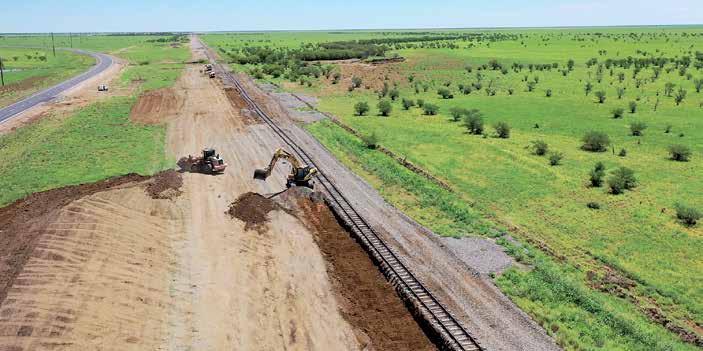
7 minute read
Queensland
from REX Aug 2019
by Prime Group
Cross River Rail ‘guaranteed’ with PPP signing
QUEENSLAND TREASURER JACKIE Trad says the formal signing of a tunnels and stations contract means the $5.4 billion Cross River Rail is guaranteed to go ahead. A $2.7 billion public private partnership (PPP) contract to build Cross River Rail’s 5.9-kilometre twin tunnels and four new underground stations was finalised with the Pulse consortium on July 1.
Trad, who championed the project despite the federal government’s decision not to support it during her time as transport minister, said the state was showing its determination to get the project done with the deal.
“Major construction will start later this year as scheduled, starting with the demolition of the Roma Street Transit Centre,” Trad said. “After the Newman LNP government scrapped this project and tore up the funding deal, we have got it back on track. Our commitment to this project will see tunnelling construction kick off next year too.”
Cross River Rail is a new 10.2-kilometre rail link from Dutton Park to Bowen Hills, a route which will include 5.9 kilometres of tunnel under the Brisbane River and CBD. On top of providing public transport to four new CBD stations, it is expected to act as a major release valve for congestion across the entire South East Queensland passenger rail network.
The scope of the tunnel and stations PPP handed down on July 1 includes the tunnel itself, from a southern portal near Dutton Park station, under the Brisbane River and the CBD, to a northern portal beyond Normanby. Then there are four new underground stations to be built ad Boggo Road, Woolloongabba, Albert Street and Roma Street.
The contract includes the portals themselves, the dive structures needed to build the stations, and all associated mechanical, electrical and safety systems, underground track work, traction power systems, and the selection of rail operation and control infrastructure.
It also includes a development opportunity above the new Albert Street station.
Separate contracts have been awarded for the rail, integration and systems side of Cross River Rail will cost the state roughly $5.4 billion.
the project, and yet another was awarded to Hitachi STS to deliver a European Train Control System Level 2 solution under a $634 million investment from the state government.
“By 2036, the south-east corner [of Queensland] will be home to nearly five million people which makes the need for turn up and go public transport essential,” Trad said.
“South East Queensland is one of Australia’s fastest growing regions, and we need to build infrastructure now that helps us keep pace with that growth. Our public transport network is nearing capacity, constrained by a single rail river crossing with all lines running through the same four city centre stations.
“Cross River Rail will unlock this bottleneck creating new capacity for the whole region as it grows, ensuring highcapacity train stations where they are needed most.”
The state’s determined July 1 signing of the PPP came in the wake of a shock federal election win for the LiberalNational Coalition, which has committed to not fund Cross River Rail. Federal Labor, by contrast, had promised more than $2 billion to the project.
Despite Queensland’s Labor state government, Queenslanders played a crucial role in returning the Coalition to power at the federal election and, in turn, handed their state government the full bill for the transformational rail project.
Light rail proposed for Sunshine Coast Airport development
SUNSHINE COAST AIRPORT HAS delivered a draft master plan for the development of the Queensland-based airport to 2040 that includes details for the creation of a light rail station.
The draft of the Sunshine Coast Airport Master Plan 2040 document was developed by Sunshine Coast Airport with key stakeholders and includes Sunshine Coast Council’s infrastructure plans under the Sunshine Coast Airport Expansion Project (SCAEP).
The airport’s document includes plans related to the provision of a possible direct rail corridor from the city to the airport. Sunshine Coast Council and the Queensland Government are investigating “numerous options for rail access” to help minimise a reliance on motor vehicle access to the airport, according to the draft master plan.
The ongoing development of the new Maroochydore central business district, a 53-hectare greenfield site development expected to cost $430 million, is also hoped to bolster the attractiveness of the region for locals, businesses and visitors, with the airport serving as a “gateway” for this development.
“[Sunshine Coast Airport] is a strong supporter of the introduction of light rail to the airport providing a fast, clean and

efficient link to Maroochydore and on to broader destinations within the region,” the draft plan read.
“Both heavy and light rail infrastructure is planned for the transformation of the region, and a connection to Sunshine Coast Airport is a critical link in the effective public transportation visions for the region.” The report went on to state a prospective light rail service would provide direct flights to domestic and international destinations byoffering seamless connections between Maroochydore CBD and the airport.

Repair work underway on the Mt Isa line after the major flooding event earlier this year.
Qld budget cuts Mt Isa charges
AUSTRALIA’S FREIGHT ON RAIL GROUP has welcomed the commitment by the Queensland Government to move more freight by rail by reducing access charges on the Mt Isa Line.
The Palaszczuk Government in June announced $80 million over the next four years to help drive a modal shift on the Mt Isa to Townsville corridor, and make rail more cost competitive.
Pacific National boss and chair of Australia’s Freight on Rail Group (FORG) Dean Dalla Valle praised the decision.
“Queensland’s regional freight network is the backbone of the state’s economy and reducing access charges on the Mt Isa to Townsville line will fast track more freight on rail, drive modal shift and support exploration in the North-West minerals province,” he said.
Dalla Valle, who spent forty years at miner BHP Billiton, noted mining and minerals processing outputs were better suited to transportation by rail, as it can handle large volumes more efficiently, while also offering safety and environmental benefits.
“Australians want to see real trains, not road trucks hauling bulk freight over long distances, to make roads safer for everyone and reduce emissions,” he said.
“Industry looks forward to working with the Queensland Government on the implementation arrangements to make rail more cost competitive and ensure more
freight from the North-West region is moved using real trains rather than road trains.”
IPA warns of ‘volatile’ royalties funding Infrastructure policy group IPA also welcomed increased road and rail commitments in the budget, but warned the state against a continued reliance on mining royalties and borrowing.
The state budget included an additional $3 billion in infrastructure funding, bringing the state’s total planned spend to $32.1 billion on infrastructure over the next four years. However, the Government is maintaining its policy not to fund new projects by privatising mature assets, a process commonly referred to as ‘asset recycling’.
IPA, an industry ‘think tank’ which has welcomed asset recycling in other states, says the infrastructure big build in Queensland is being built on ‘shaky fiscal foundations’ without asset recycling.
“Infrastructure funding underpinned by volatile mining royalties and increased debt is not a long-term recipe for success,” IPA chief executive Adrian Dwyer said.
“If the Queensland Government wants to sustain high levels of infrastructure spending while keeping debt in check, they will have to come back to the table on reform and asset recycling. Without additional capital from asset recycling and wider reform, the Queensland Government will remain fiscally
constrained in the face of a rapidly growing population.”
The state seems unlikely to buckle to federal pressure to privatise assets to support further infrastructure spending, however.
With federal treasurer Josh Frydenberg in the news early in July discussing the potential of a second Asset Recycling Fund, which would provide extra federal funding for states who sell public assets, Queensland’s deputy premier and treasurer Jackie Trad reiterated her position on the matter.
“Scott Morrison can put as much money on the table as he likes but we are not going to sell our energy assets or our ports,” Trad told the media on July 9.
“Queenslanders have been abundantly clear on this. They do not want their assets sold ... we made a commitment to the people of Queensland and we are keen to keep that commitment.
“Queensand is not getting the amount of money that we should, as 20 per cent of the population, for critical infrastructure projects.”
Federal infrastructure minister Michael McCormack responded 22.8 per cent of the Coalition’s infrastructure pipeline was allocated to projects in Queensland.
“We have the money on the table and it’s ready to be spent. All we need now is for the Queensland government to confirm when they need it and start putting shovels in the ground,” McCormack said. “The people of Queensland have been waiting long enough.”










